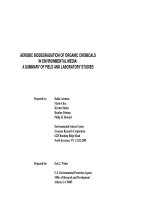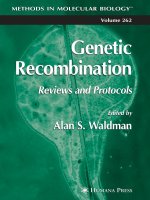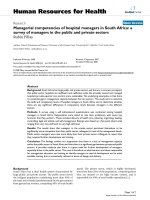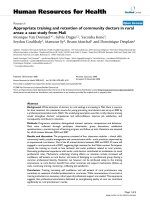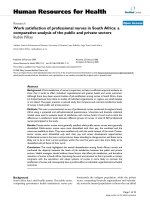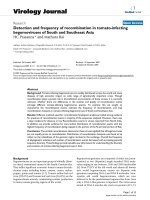Recombination variability and evolution, algorithms of estimation and population genetic models a b korol (chapman and hall, 1994)
Bạn đang xem bản rút gọn của tài liệu. Xem và tải ngay bản đầy đủ của tài liệu tại đây (45.51 MB, 384 trang )
RECOMBINATION
VARIABILITY
AND
EVOLUTION
ALGORITHMS
OF ESTIMATION AND
I'OPL'LATION-GENETK
MODELS
Copyrighted material
Copyrighted material
Copyrighted material
Recombination Variability
and Evolution
Copyrighted material
Copyrighted material
Recombination
Variability
and Evolution
ALGORITHMS OF ESTIMATION AND
POPULATION-GENETIC MODELS
A.B. Korol
Institute of Evolution,
University of Haifa, Israel
LA. Preygel
Genetic Therapy. Inc..
Gaithersburg. USA
and
S.I. Preygel
Oncor, Inc., Bethesda. USA
El
CHAPMAN & HALL
London ■ Glasgow > Weinheim * New York - Tokyo ■ Melbourne ■ Madras
T h i s
One
PZYN-UXU-D9HT
Published b> Chapman and Hall. 2 - 6 Boundary Row, London SEI 8IIN.
UK
Cliapman and Hall. 2 - 6 Boundary Row. London SE! 8HN. UK
Blaekie Academic and Professional. Wester Cleddens Road. Bishopbrtggs.
Glasgow G64 2NZ. UK
Chapman and Hall GmbH. Pappelallee. Í. 69469 Weinhelm. Germany
Chapman and Hall USA. One Penn Plaza. 41st Floor New York NY 10] 19*
USA
Chapman and Hall Japan, ITP-Iapan. Kyowa Building, *F. 2-2-1 HLrakawacho.
Chiyodn-ku» Tokyo 102. Japan
Chapman and Hall Australia. Thomas Nelson Australia.
102 WxUis Street. South Melbourne. Victoria 1205. Australia
Chapman and Hall India. R. Scshadri, 12 Second Main Road. (IT East.
Madras bOO 0 1 5 . India
Pint edition 1994
©
1994 A.B. KoroL LA. Preygel and S.I. Preygel
Adapted from Russian language edition - Variability of Crossin$over in tii$\ttr
Organisms: Methods of analysis and Population Genetic Models - 1990. A.B. Korol.
[.A. Preygel and S.I. Preygel
Published by Shtilntsa Press. Kishinev. Moldova
Typeset In IO/12 Photlna by Thomson Press lindia) Ltd. New Delhi. India
Printed In Great Britain by T.|. I*ress iPadstowl Ltd. Padstow. Cornwall
ISBN O 412 4S410 8
Apart from any fair dealing for the purposes of research or private study, or
criticism or review, as permitted under the UK Copyright Designs and Patents
Act. 198ft. this publication may not be reproduced, stored, or transmitted, in
any form or by any means, without the prior permission in writing of the
publishers, or in the case of reprographic reproduction only in accordance with
the terms of the licences issued by the Copyright licensing Agency in t h e ! "K. or
in accordance with the terms of licences issued by the appropriate Reproduction
Rights Organization outside the UK. Enquiries concerning reproduction outside
the terms stated hen? should be sent to the publishers at the London address
printed on this page.
The publisher makes no representation, express or implied, with regard to the
accuracy of the information contained in this book and cannot accept any legal
responsibility or liability for any errors or omissions that may be made.
A catalogue record for this book is available from the British Library
Library oí Congress Catalog Card Number: 94-70270
(¿j Printed on acid-frcc text paper, manufactured in accordance with ANSI/
NIS0ZJ9.48-1992 and ANS1/NIS02J9 41* 1984 4 Permanence of Paper).
Contents
Prpfarp
vil
Acknowledgements
ix
Inlrmlnrtinn
Part One
1
|
ESTIMATION Ol HH OMHINATION
Z
General survey of methods for estimating
recombinational variability
1.1 Recombination ÜS a source of genetic variation
1.2 Spectrum of rcconibinalional variability
1.Í Kvaluatinu changes in variability spectrutn
1,4 Marker and evtolosical analysis of recombination
9
9
li
l_h
24
2
Marker analysts
2.1 Formulation of genetic recombination
2.2 LstimathiR recombination from experimental data
2. Í Some examples of crossing-over frequency estimation
2.4 Allowing for data heterogeneity In estimating linkage
2.5 Models of quasMmkage
JO
50
i_7
4fi
S_l
55
5
Marker analysis of quantitative traits
L1 The Mendelian approach to quantitative variation
L2 Estimating (JTI, marker linkage in controlled crosses
71
7]
76
Li
Quantitative trait analysis with two and more markers
92
L4
L5
Marker analysis of a set of quantitative traits
(ieneral discussion and prospects of the problem
Part Two
4
11)1
104
POPULATION GENETIC MODELS OF INTERACTION
BETWEEN SELECTION AND RECOMBINATION
The genetic system and recombination
4.1 The 'genetic system* concept
I_L5
117
117
Copyrighted material
CONTENTS
4*2
4.3
4.4
5
6
7
Rernmhinalion n n n - r a n H n m n ^
Linkage of co-adapted and functionally related genes
Parallelism of synlenic groups
Effect of r e c o m b i n a t i o n o n p o p u l a t i o n genetic s t r u c t u r e
5.1 The genome integrity as a protection against excess
variability
1 2 InftTactinn between election and rccomhination
LÍÜ
JJJ
Evolution of t h e system controlling r e c o m b i n a t i o n
6.1 A review of theoretical explanations
6.2 Genetic variation in exchange frequency and distribution
6.3 Artificial selection for altered recombination frequency
6.4 Two problems in explaining the rec system evolution
) 5ft
15£
125
186
192
OS
Selection for Increased r e c o m b i n a t i o n d u e to
^nilrnnmrnf^l niirtnafimiB
1 Q»
7.1
7.2
7.3
7.4
13&
1Ü9
202
212
The problem
Description of the model
Results
Experimental modelling of the rec system microevolullon
& Species I n t e r a c t i o n s as a factor in t h e evolution of
i
recombination
ÜJ [nimducUQD
8-2 A model of co-evolution with selection on gene
combinations
& J A model of r e v o l u t i o n with selection on the characters
'resistance' and Virulence'
8.4 The rec system evolution under intraspecitic competition
9
1 22
1 if)
1 Í3
Evolutionary i n t e r p r e t a t i o n of r e c o m b i n a t i o n
phenomenology
9.1 The role of recombination dependence on environment
i 9,2 The evolution of dominance of rec genes
9. i Linkage between the rec modifier and its target region:
a possible evolutionary model
22fi
12h
2_il
2A5
¿5h
26.0
2hil
222
¿22
¿&Ú
i
l> a rt Three
CONf I IDIOMS
rnnrlnglnng
2JLZ
2S*J
i
References
Inde»
294
155
Copyrighted material
Preface
It is no exaggeralion to say that Ihe recombination studies initiated by the
Morgan school at the turn of this century determined the general lines along
which the development of genetics was to proceed for many years to come.
With time, the focus passed to the problem of mutations which affect the
relations of genetics with other biological disciplines, in particular with
evolutionary theory and breeding. In early works on the synthetic theory of
evolution, the role of recombination as a source of heritable variation was
ignored (Mayr. 1980). Later, the situation changed as a result of the studies of
Darlington. Dobzhansky. Huxley. Mayr. Mather and others. Nevertheless.
many evolutionary conclusions were based on fairly naive notions of complete
randomness of recombination variability, going back to the concept of 'beanbag genetics'. Recombination was viewed as a purely mechanistic process
ensuring reshuffling of genes in heterozygotcs.
Many types of recombination are known, from recombination of whole
chromosomes (the basis of Mendel's law of independent assortment of genetic
factors) to crossing over, gene conversion, transformation and transductton.
The study of genetics has accumulated abundant evidence on both the
peculiarities and common features of these processes in various organisms, on
their genetic control and on the molecular mechanisms involved. However.
despite a long history and thousands of studies, recombination continues to be
a puzzle with respect to its mechanisms, the diversity of genetic and evolution
ary effects (or 'functions') seen and. particularly, the factors which determine
its own evolution.
The problem of the evolution of recombination as part of a more general
problem of the evolution of sex has become one of the 'hotspots' of population
biology and is the object of intensive studies by theoreticians. Unfortunately.
the progress (modest as It is) that has been made In this area is hardly matched
by experimental studies and field observations. There is no doubt, however,
that genuine insight into this problem can only be gained by Intimate
interaction between theory and experimentIn recent years, as a result of the extensive use of molecular markers in
genetics, recombination has received growing attention as a subject of applied
Copyrighted material
rKKFACK
research. The amount of work in recombination-based genetic mapping that
has been done in the course of a few years exceeds that which has been carried
out during all the preceding history. Modern methods of mapping have opened
up entirely new opportunities for analyzing the genetic topography of quanti
tative traits. This has resulted i n wide breeding application, and the use of this
approach may be equally important in studying the genetic control of fitness
traits in natural populations and in replacing 'beliefs' and a priori assumptions
by rigorous analyses. It appears that joint consideration of these lines of
enquiry, i.e. (a) phenomenology* mechanisms and genetic control of recom
bination. (b) genome mapping and marker analysis of quantitative traits and
{c) the evolution of recombination, unrelated as they might seem land really
are», can shed some new light on the general problem of recombination. At
any rate, we hope that the attempt to discuss these issues i n an interdisciplinary
way. as described in this book, will be of some interest to researchers from
various fields (e.g. geneticists, evolutionists, breeders), will renovate theoreti
cal explanation of many common features of recombination and may. as
a result provoke new experimental and field studies of the rec system microevolution. One of our main objectives when writing the book has been to justify
the adaptalionist interpretation of basic features of recombination, primarily of
crossing over.
A. Koroi.
University of Haifa. Haifa.
Israel
Copyrighted material
Acknowledgments
This book is a revised version of our book Variability of Crossing Over in Higher
Organisms, which was written when Ihe authors were based at the Institute of
Genetics. Academy of Sciences of Moldova (Kishinev), and was published in
Russian by Shtiintsa Press (Kishinev) In 1990.1 take this opportunity to thank
our friends and colleagues from the Institute and especially the collaborators of
my laboratory. Some of the results represented in the book are the products of
their active participation. The Knglish revision coincided with emigration of
the authors to Israel (Haifa. A.K.) and USA (Gatthersburg. Maryland. I.P. and
S.P.). The work would thus have been impossible to complete without the
humanitarian and professional helpof my new colleagues from the Institute of
Evolution. University of Haifa. Drs Y. Ronin. V. Kirzhner and Zhanna
Kovalevskaya: I thank them wholeheartedly. I would like especially to thank
Professor Eviatar Nevo for his profound understanding of the scientific and
practical problems that I encountered, sincere personal interest and everyday
encouragement.
I would also like to extend my gratitude to the patience and help of my wife.
Bella, who helped me immensely in the computer text-processing work of the
new English version.
G.K. Lakhman has translated this book from Russian into English. His
professional skill and persistence improved the text and clarified the formula
tions. The authors, of course, bear the full responsibility for the textual
content.
The authors are also indebted lo Professors M. Soller and S.M. Gershenson,
the late Dr Batia Iavie, Dr A. Beiles and to the unknown referees for reading the
manuscript and for their valuable comments and suggestions. The revision
was financially supported by Grant No. 3675-1-91 of the Israeli Ministry of
Science, the Wolfson Family Charitable Trust and the Instituí Alain de
Rothschild. I gratefully acknowledge the support of these Foundations.
Copyrighted material
Copyrighted material
Introduction
In the early days of genetics many Important problems were solved using
higher plants as experimental organisms. Later, extensive use olDrosophila as
a model organism resulted in rapid progress in this science, which not only
enhanced the power of its techniques and the reliability of the obtained results
but also broadened the range of the problems studied. However, a changeover
in the leading model organism caused no disruption in the continuity of
development of genetics.
Large-scale recombination studies initiated by the Morgan school, determin
ing the general lines of enquiry for many years to come, were central to
classic genetics. Recombination formed the basis of analytical methodology
of the entire science of genetics (Carson» 1957). The beginning of the next
(molecular) stage in the development of genetics (the 1940s to 1950s)
coincided with the extensive use of fungi, bacteria and viruses in experimental
work. A new changeover in model organisms has resulted in a decline in the
importance of h y brido lógica I analysis based on recombination techniques.
with molecular biological methods playing an ever-increasing role. The
exceptional efficiency of the latter is common knowledge. Considerable pro
gress has been made over a short period of time in trying to solve the most
important issues of genetics, including advances in recombination studies, and
generated reductionist overoptimism (Maddox. 1993). Recently, the opinion
has gained currency that general genetics has fulfilled Its task and its subject of
investigation has been largely exhausted, with only biochemistry, biophysics
and molecular biology being capable of providing further progress in the
cognition of life.
Indeed, advances in these disciplines have revolutionized genetic studies as
a result of the development of new analytical techniques. These could permit,
for example, a considerable portion of the genome to be mapped and followed
through generations in various organisms. Including man. In whom previous
ly this was possible but only on a very small scale. In addition, these techniques
enable cloning of genes controlling the key metabolic and developmental
stages of economically important traits in plants and animals as well as fitness
components in natural populations. Nevertheless, many problems of para-
Copyrighted material
INTRODUCTION
m o u n t importance formulated d u r i n g the classical period of genetics h a v e
never been solved, a n d , h a v i n g lost their former edge, are pushed somewhat
i n t o the background f o l l o w i n g the replacement o f model organisms. These
processes o f specialization a n d reduction have even affected e v o l u t i o n a r y
studies i n w h i c h the systems approach is a prerequisite for success (Noordwijk,
1990).
As pointed o u t by Grant ( 1 9 7 5 , p. 4 5 7 ) 'dominance o f molecular a n d
microbial genetics
is n o t a result o f progressive changes w i t h i n a single
field, but is instead a replacement o f one field by another. Scientific problems
came up w h i c h called for a different breed of workers. One body o f knowledge
became half-forgotten, or never learnt in the case o f the y o u n g e r w o r k e r s .
w h i l e a n o t h e r distinct body of knowledge w i t h the same s u r n a m e 'genetics*
grew up i n ils place* Historical c o n t i n u i t y was partly lost in the process'. Such
a n appraisal of the situation in genetics of the late 1960s t o m i d - 1 9 7 0 s was o n
the w h o l e correct, pessimistic as it m i g h t seem- T h e problem lies in the
inadmissibility o f extrapolating t o higher organisms the results f r o m l o w e r
ones. Such a n extrapolation, warranted t h o u g h it m a y be, can result in either
serious mistakes or even w r o n g conclusions. Nevertheless, by the late 1970s,
Drosophifa a n d some plants again became popular model organisms, a n d
deservedly so.
I n the last t w o decades, fundamentally new i n f o r m a t i o n o n the fine struc
ture o f genetic material has been obtained o n higher eucaryotes. The mosaic
structure o f genes has been revealed, as w e l l as enormous differences in D N A
content between related species. A special class o f genetic elements, the
so-called mobile dispersed genes* have been discovered in the nucleus. I n view
of recent findings, the eucaryotic genome Is envisioned as a n extremely
complex non-homogeneous system in w h i c h 'islands' of stable s t r u c t u r a l gene
groups are s u r r o u n d e d by numerous continuously v a r y i n g repeated
sequences (Georgiev etaL
1 9 7 7 ; H u n k a p i l l e r etal,
1982: Khcsin, 1984:
McClintock; 1 9 8 4 ; Golubovsky, 1 9 8 5 ; Finnegan. 1 9 8 9 ; K a r l i n a n d Brendel.
1 9 9 i ; M o r e l l , 1991).
The importance o f recombination as a crucial factor d e t e r m i n i n g the
balance between Ihe stability a n d d y n a m i c properties o f genetic organization
as w e l l as the interplay between heredity and e n v i r o n m e n t has been increas
ingly recognized. In recent years, research has focused o n various aspects of
recombination (unequal crossing over, gene conversion, chromosome rear
rangements) a n d their impact o n genome e v o l u t i o n , p a r t i c u l a r l y its
components such as multigene families (Ohta. 1 9 8 6 ; Fiavell, 1 9 8 6 ; S l a t k i n ,
1 9 8 6 ; Walsh, 1 9 8 7 ; Petes a n d H i l l . 1 9 8 8 ; Basten and O h m , 1992). A c c o r d i n g
t o c u r r e n t understanding, recombination is the m a i n factor b e h i n d the
so-called concerted evolution of these most i m p o r t a n t genomic components of
higher eukaryotes (Dover. 1986)* One of the prerequisites for concerted evolu
tion is a balance between the rate o f m u t a t i o n s t h a t disrupt the structure of
gene family members a n d the frequency o f conversions ensuring s t r u c t u r a l
Copyrighted material
i
INTRODUCTION
unity (Walsh. 1987). Conversions may also be a mechanism for mobile
element transposition (Evgenjev et a/., 1982: Geyerrto/.. 1988).
Directed (site-specific) recombination is a useful approach In developmental
genetics (Golic. 1991: Simpson. 1993). Genetically controlled reduction of
recombination based on meiotic mutants may substantially increase the
stability of genomic libraries of humans and other species maintained in yeast
artificial chromosomes (Brown. 1992). The problems of recombinational
repatterning of foreign genetic material in transgenic organisms produced by
transformation have also received growing attention in recent years (e.g.
Subramani and Rubnitz. 1985; dimmer and Grass. 1989).()neof the reasons
for this interest is the effect of recombination events on the stability of
transformants (Muller etal, 1987). Homologous recombination is becoming
a powerful tool for genetic manipulation at the cellular level (site-specific
modification of genetic material), allowing the induction of disorders in target
genes or. conversely, the correction of the detected disorders and the replace
ment of endogenous defective genes by cloned DNA sequences (Anderson.
1992).
Finally, one cannot help mentioning here such an unusual form of recom
bination as horizontal transfer, which allows the flow of genetic information
unrestricted by reproductive barriers. While conclusive evidence on the
subject is still lacking, many authors admit (Khesin, 1984; Ayala and Kiger.
1984; Krasilov. 1986). and some are strongly confident, that the process does
occur in nature and plays an important role in evolution (Kordyum. 1982;
Syvanen. 1985;Grandbastien, 1992; Robertson. 1993).
These findings are ever more frequently at variance with classical genetics
and conventional postulations of evolutionary theory. The current situa
tion obviously necessitates a drawlng-up of an inventory of the accumulated
facts and a re-examination of the older ideas. That is to say. there is a need
for a new synthesis in evolutionary biology (Krasilov, 1979; Campbell,
1982; Hunkaplller«
synthesis should probably be preceded by extensive experimental and field
testing, on a regular basis, and by the refinement of major groups of models,
The next step will be to develop a 'reconciled' version of the theory of evolution
and to elaborate the metatheory(Lewontin. 1974: Lyubischev. 1982;Meijen,
1984; Iwasa. 1988; Ratner. 1990).
Bridging the gap between what is known about the genome structure, on
the one hand, and its functional organization, on the other, is one of the main
objectives of molecular genetics. Ultimately, this knowledge should become
port of the overall system of genetics and evolutionary theory and contribute
towards the solution not only of new problems but also of those that have been
the subject of general and evolutionary genetics for more than half a century,
These are. in particular, the spatial, temporal and functional organization of
Copyrighted material
INTRODUCTION
the genomes of higher organisms» patterns of the genetic transformation in the
course of natural and man-directed evolution and the relationship between
germ plasm architecture' (Weismann's term) and the functioning of the
organisms in varying environments. Rapid progress towards the solution of
the problem of the genome structural organization Is now apparent. The
modern molecular revolution has dramatically increased the power of genetic
analysis, thus opening up opportunities for solving a wide range of problems.
It is no exaggeration to say that this breakthrough will ensure a multidisciplinary synthesis in biology.
Investigation of a complex system cannot be confined to the theoretical
arguments explaining the behavior of all its component parts. The synthesis
must be capable of predicting the behavior of the system as a whole and
perceive the mechanisms governing that behavior- Actually, such a synthesis
is usually much more difficult to achieve than the analysis. Thus, population
genetics has mathematical techniques for describing and analyzing the be
havior of a wide variety of one- and two-locus systems. However, they cannot
be used to predict the behavior ofT say. a five-locus system (Lewontin, 19741,
The only way out has so far been computer simulations of various particular
situations or analytical studies of multilocus systems satisfying certain, some
times very rigid and unrealistic, constraints (Kempthorne, 1988). It is com
mon practice to make assumptions of weak selection, no linkage disequili
brium, normal distribution of the effects of mutations, lack of genotypeenvironment interaction (or very special forms of this interaction), and so on.
As Wright (1965. p.81) pointed out. The attempt to introduce exact
mathematical treatment leads in all but the simplest cases to such complexity
that the results arc of little use in the general theory.' Despite the obvious
progress in theoretical studies over the past 50 years, this appraisal remains
generally true.
One can imagine a situation in which, for every individual of a population.
DNA sequences of the entire genome, the whole inventory of structural and
regulatory genes, etc., are known. But even with this information. It Is hardly
possible to predict the population composition for several generations ahead
and to ascertain the probability of the population survivorship within a given
community. This task appears to be a formidable one in view of the need to
allow for the population size, variability, breeding system, etc, (Nunney and
Campbell, 1993). Also. It Is not easy to solve the reverse problem, that is to
reconstruct, based on the available data, the history (even if a recent one) of
a given population. This is even true for situations in which mutations are the
only source of heritable variation (Levin and Castillo-Chavez. 1990).
In predicting mlcroevolutionary changes in real systems. Interactions
between two classes of fundamental processes - ecological (energy and matter
transformation) and genetic (genetic information transmission) - should be
taken Into account (Eldredge, 1986; Yablokov, 1987; Wohrmann and Jain,
1990). Formulation of the ecological genetic theory of adaptive responses is
Copyrighted material
S
INTRODUCTION
one of the problems whose solution will offer ample scope for applying genetics
in managing natural ecosystems and agrocenoses and in breeding work.
Obviously, these problems are intertwined with those of developmental gene
tics. selection theory, ecology, population and evolutionary genetics, and
evolutionary theory as a whole. In all these fields, the problem of genetic
variation, and» In the first place, that of recombination» Is a central oneBeing a key component of the sexual system, recombination has turned out
to be closely coupled with other fundamental processes such as DNA replica
tion and repair. Mendelian segregation of homologs and assortment of nonhomologous chromosomes. Some of these processes share components in
genetic control and molecular mechanisms and exhibit overlapping effects on
genetic variation and synergistic pattern of co-cvolution of their genetic
determinants. Considering that species, genotypes, chromosomes and
genomic regions vary widely in detail, this makes the task of providing simple
explanations, and general rules and patterns, as well as formulating reasonable
predictions for experimental and Held testing, a real challenge.
In our view, one of the factors limiting the rate of progress in understanding
this problem is the gup between the studies of molecular mechanisms, pheno
menology. genetic control and the population genetics of recombination.
Important findings in one of these fields are often unknown in others. For
instance, such common properties of recombination as interference of ex
changes and variation In their frequency and genomic distribution with
ecological conditions have almost remained unconsidered from the population
genetic standpoint. Nor are the peculiarities of recombinational organization
of the genome adequately taken Into account in the applications of genetics to
breeding, including the quantitative trait locus mapping. On the other hand.
evidence from studies of genetic determination of quantitative traits, abundant
data on block organization and epistatic interaction of adaptively valuable
gene complexes are often ignored in present-day multilocus models.
All this implies that further progress toward a better understanding of
genetic recombination as a phenomenon of general biological significance is
only possible based on the joint application of various approaches and
techniques at every level of life organization. It seems certain, therefore, that
the future synthesis in recombination studies will be preceded by a fairly long
period of analysis and accumulation of evidence on Interdependence and
co-evolution of processes at the level of DNA and chromosome, cell and
organism, population and ecosystem. An important step in estimating the
progress in understanding the evolutionary functions of recombination within
the framework of such a Vertical1 approach will be the analysis of ecologicalgenetic population models with subsequent testing of their predictions by
experiments and based on observations of natural populations.
Copyrighted material
Copyrighted material
PART ONE
Estimation of Recombination
Copyrighted material
Copyrighted material
General survey of
methods for estimating
recombinational variability
i
1.1 RECOMBINATION AS A SOURCE OF GENETIC VARIATION
Gene mutations constitute a primary source of genetic variation in all living
forms. In microorganisms exhibiting higher reproduction rates, mutations
offer possibilities for rapid gcnotypic adaptation under sudden environmental
changes, with a population surviving as a result of individual genotypes
carrying rare favorable mutations. Multicellular forms have considerably
lower reproductive rates, resulting in a higher value of each individual to the
population as well as in increased individual plasticity and in coordination of
physiological processes (Schmalhausen, 1942). These factors necessitate an
increase in both the functional and structural Integrity of genetic material and
a rise in the hierarchical level of elementary units of genotypic adaptation by
switching from genes as units of selection to co-adapted gene blocks, thereby
changing the relative roles of mutation and recombination as sources of adap
tive genotypic variation (Darlington, 1939: Mayr. 1963,1982: Schmalhausen,
1968; Severtsov. 1981; Grant, 1985: Zhuchcnko and KoroL 1985).
Increased complexity ultimately means a higher number of hierarchical
levels in the system, with mutations at individual loci being incorporated in the
population gene pool only after having been tested in combination with many
other polymorphic genes, A possibility for such testing is provided by recom
bination. Naturally, testing of each new gene (gene combination) occurs in the
context of an already formed system exhibiting a high internal balance and
adaptedness to environmental conditions (Mayr, 1970; Lewontin. 1974;
Ayala and Klger, 1984). Internal balance is also reflected in non-randomness
of the recombinational variability spectrum and in the dependence of ex
change frequency and distribution on environment and genotype. The process
Copyrighted material
METHODS FOR ESTIMATING KKCOMBINATIONAL VARIABILITY
of generating primary genetic diversity by mutation is. in a sense, also optimal
and internally adjusted (Tchaikovsky, 1976;Krasilov. 1979; Campbell. 1982:
Borstnik. Pumpernik and Hofacker, 1987).
Estimates from various Drosophtla species indicate that 2 5-40% of variation
In fitness observed in natural populations is regenerated by crossing over in
one generation from the gene content of a randomly drawn chromosome pair
(Dobsshansky. 1959; Mayr, 1970). This led Dobzhansky to conclude that
a temporary arrest of the mutation process would not result in a significant
decrease in variation over a large number of generations. The same view is
held by Ayala (1981), who argues that for the variation stored in a population
to be accessible to selection for a number of generations recombination alone is
enough without mutation,
In fact, variation generated de novo by the mutation process is lower by
orders of magnitude. This Is particularly the case In view of the large amount of
genetic variability (and heterozygosity) present in natural populations dis
covered in the 1960s by the method of protein electrophoresis and subsequent
ly confirmed at the UNA level (Hubby and Lcwontin. 1966: Lewontln. 1974:
Nevo. 1 9 7 8 . 1 9 8 8 a , 1 9 9 1 ; Ayala, 1983; Gilbert* ai. 1990; Nevort aL 1990;
Laurie. Bridgham and Choudhary. 1991; Erlich and Arnheim. 1992; Jiang
id Gibson. 1992). All other things being equal, genetic variance for a sexual
)pu!ation with free recombination may be several times that for a population
/ith no recombination (Charlesworth, 199Í), Notwithstanding the known
theoretical difficulties, the idea of polymorphism and heterozygosity being
extremely important for the adjustment of organisms to varying environments
(blotic and abiotic) is the central one in modern population biology te.g, Ayala
and Kiger. 1984; Nevo. Beiles and Bcn-Shlomo, 1984; Brcmermann. 1987:
Nevo. 1988b: Barton and Clark, 1990: Hamilton. Axelrod and Tañese. 1990;
Aquadro. 1992).
The possibility of a rapid restoration of enormous genetic variability be
comes of particular significance in higher eukaryotes with long life cycles
and/or those experiencing the bottle-neck effect (Bryant, McCommas and
Combs 1986: Bryant and Meffert. 1988: Carson, 1990). Finely adjusted
systems of recombination control found in these organisms provide a trade-off
between the need for maintaining high levels of fitness and preserving genetic
plasticity (capacity for future variation i. a compromise hardly attainable in the
absence of recombination (Darlington, 1939: Grant. 19581One way to classify genetic variability is to subdivide it into potential ana free
ariablllty. Concepts of the above types of variability were introduced by Fisher
1930) and elaborated by Mather (1943), although Chetverikov 11926) was
the first to advance the idea of a large amount of heritable variability concealed
In natural populations. Free variability manifests itself in genotypic differences
accessible to selection- These differences can result from new mutations as well
as the release of potential variability (stored in the form of heterozygosity! by
recombination and segregation (Figure 1.1), Crossing is the main process
(
Copyrighted material
I
11
RECOMBINATION AS A SOURCE OF (¡liNITIC VARIATION
Free vanaDifrty
AABB+aabb +
aaSS ^ Aat)t> +...
^ration /
•
Mutatton
Migration
Mutation
Re~mb.na.cn
Segregation
AaBb
Potential variability
stc*ed in h&terozygotes
Figure I.I Variability conversions in populations Ifrom Zhuchenko and Korol.
1985).
resulting in interconverslons of Ihc above I wo types of variability* Inbreeding
leads 10 a potential -* free' transition, providing material for selection to act
upon. Outbreeding produces new heterozygotes (hat could be considered not
only as selectable genotypes but as reservoirs* of potential variability as well.
In a population, both pr<>ccsscs arc continuously occurring, with the
Tree -* potential* transition creating preconditions for the emergence of new
variability in subsequent generations*
From the "naive* point of view* the above processes constitute (he essence of
sexual reproduction, diploidy and recombination. Diploidy offers great possi
bilities for generating new alíeles without a substantial reduction in current
fitness. Sexual reproduction allows favorable mutations to be assembled in
a single organism, with recombination producing a wide variety of combina
tions of newly arising alíeles with those previously accumulated*
The role of recombination as a factor affecting genetic variability is contro
versial, It produces new alíele combinations - raw material for directional or
diversifying selection* Likewise, under free mating it tends to destroy any
deviations from the population mean, thereby helping the stabili/Jng selectionThrough gene duplications (by unequal exchanges), recombination creates
prerequisites for increasing variability (Serebrovsky. 19ÍK; Mather, I 9 5 Í ;
Ohno. 1970). However, recombination is considered to be a factor maintain
ing homogeneity within a multigene family fOhta, 1986). The efficiency of
recombination as a source of variability depends on the breeding system, life
cycle duration, ploidy level and chromosome number as well as on cross-over
frequency and distribution and on their genetic and environmental variation
(Chapters 4 and 6).
Although studies of factors; affecting recombination have occupied a promi
nent place in genetics, they have always had quite different aims to pursue.
namely elucidating genetic topography, mechanisms of recombination, tem-
Copyrighted material
